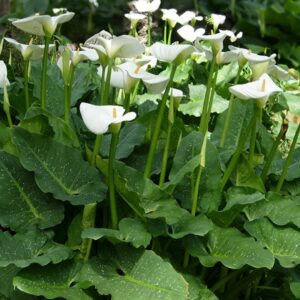Your cart is currently empty!
A Comprehensive Guide to Planting Calla Lilies and Arum Lilies

Introduction
Calla lilies (Zantedeschia spp.) and Arum lilies are celebrated for their elegant and striking blooms. Proper planting techniques are crucial to ensure these plants thrive. This comprehensive guide covers everything you need to know about planting Calla and Arum lilies, from bulbs to seeds, incorporating the best practices from various expert sources.
Planting Calla and Arum Lily Bulbs
Depth and Spacing
When planting Arum lily bulbs, depth and spacing are critical for healthy growth:
- Depth: Plant Arum lily bulbs about 5 cm deep.
- Spacing: Space the bulbs 30 to 40 cm apart to allow adequate room for growth and air circulation.
Soil Preparation
Proper soil preparation ensures the bulbs have the nutrients and conditions they need to thrive:
- Composting: Incorporate well-decomposed compost into the soil to enrich it and improve moisture retention.
- Loosening Soil: Use a fork or tiller to loosen the soil before planting, ensuring good drainage to prevent waterlogging.
Planting Season
The best time to plant Arum lily bulbs is in the spring, after the risk of frost has passed. This timing ensures that the soil is warm enough for the bulbs to start growing.
Growing Calla and Arum Lilies from Seeds
Starting Indoors
Starting Arum lilies from seeds indoors can provide a controlled environment, promoting better germination and growth:
- Seed Preparation: Soak the seeds in warm water for 24 hours before planting to soften the seed coat and enhance germination.
- Sowing Seeds: Sow the seeds on the soil surface in seed trays or small pots at the start of spring. Plant the seeds at a depth of about 5 cm with an 8 cm spacing.
- Germination Conditions: Maintain a temperature between 21°C and 28°C. Ensure the seeds receive plenty of light, which is crucial for their growth. Germination typically takes 1 to 3 months.
Transplanting
Once the seedlings are strong enough and the risk of frost has passed, they can be transplanted outdoors:
- Transplant Timing: Transplant in the spring after the last frost.
- Preparation: Ensure the new planting site is well-prepared and enriched with compost.
Optimal Growing Conditions
Soil Requirements
Calla and Arum lilies thrive in well-composted, loose, free-draining soils with a pH level between 6.0 and 6.5:
- Organic Matter: Enrich the soil with plenty of well-decomposed compost and manure. This improves soil fertility and moisture-holding capacity.
- Drainage: Ensure the soil drains well to prevent waterlogging, which can cause root rot.
Temperature and Light
These plants prefer specific temperature and light conditions to thrive:
- Arum Lilies: Prefer a semi-shaded environment, especially where there is no permanent water nearby.
- Calla Lilies: Can tolerate full sun near water sources.
- Temperature: Maintain a daytime temperature of around 18°C and a nighttime temperature of 16°C. Protect the plants from severe frost.
Watering and Irrigation
Consistent watering is essential, especially during the vegetative growth phase:
- Irrigation Systems: Use drip and overhead irrigation systems to maintain soil moisture levels. Avoid overwatering to prevent root rot.
- Senescence Phase: Reduce watering as the plant enters senescence to prepare it for dormancy.
Fertilization
- Active Growth: Apply a high-nitrogen fertilizer every two weeks during active growth phases.
- Post-Flowering: Switch to a high-potassium fertilizer once a week after flowering to encourage strong rhizome development.
- Slow-Release Fertilizers: Use a balanced slow-release fertilizer in spring and summer for steady nutrient supply.
Pest and Disease Management
Common Pests
- Thrips and Aphids: Implement a preventative spray program during the flowering phase. Use insecticidal soaps or chemical treatments as necessary.
- Larger Pests: Use physical barriers or deterrents to protect the plants from porcupines, wild pigs, and birds.
Diseases
- Rots: Arum lilies are susceptible to various rots, including crown rot, root rot, and pythium rot. Ensure well-drained soil and avoid overwatering to prevent these diseases.
- Fungal Infections: Regularly remove dead and decaying debris to reduce the risk of powdery mildew, gray mold, and blight.
Insights from Expert Sources
- General Planting Tips: Calla lilies require rich, well-drained soil and prefer full to partial sun. They should be planted in spring and bloom in summer. Regular watering and balanced fertilization every 2-3 weeks during the growing season are crucial.
- Soil Enrichment: Calla lilies thrive in moist, well-drained soil with plenty of organic matter. Bulbs should be planted 5-10 cm deep in spring, with even soil moisture maintained. A sunny or partially shaded location is ideal.
- Frost Protection: Zantedeschia (Calla lilies) need a sunny position with moist, well-drained soil. They are ideal for borders and containers, requiring regular watering and feeding during the growing season. Frost protection through mulching or lifting rhizomes in colder regions is recommended.
- Seasonal Planting: Calla lilies should be planted in spring in well-drained soil with plenty of organic matter. They prefer full sun to partial shade, regular watering, and fertilization every 4-6 weeks.
- Moisture Maintenance: Arum lilies (Zantedeschia aethiopica) prefer moist, rich soil and a sunny or partially shaded location. Rhizomes should be planted in spring, with consistent soil moisture. They are ideal for borders, pond edges, and containers.
- Winter Care: Calla lily rhizomes should be planted in spring, 5-10 cm deep in well-drained soil. They prefer sunny locations and regular watering, with fertilization every 2-3 weeks during the growing season. In colder regions, rhizomes should be lifted and stored in a cool, dry place over winter.
- Soil pH and Fertilizers: Arum lilies require rich, well-drained soil and prefer semi-shaded environments. Regular watering and fertilization are essential, with protection from frost in colder climates.
- Pest and Disease Management: Calla lilies need well-drained soil, regular watering, and balanced fertilization. They are susceptible to various pests and diseases, including thrips, aphids, and fungal infections, requiring proactive management.
Conclusion
Planting and caring for Calla and Arum lilies require attention to detail and adherence to best practices in soil preparation, planting, and maintenance. By following these detailed guidelines, you can ensure the successful growth and propagation of these beautiful plants. With proper care, your Calla and Arum lilies will thrive, providing continuous blooms and enhancing your garden’s aesthetic appeal.
By incorporating insights from expert sources, you can master the art of planting these exquisite flowers, ensuring they flourish and bring beauty to your garden.








Leave a Reply